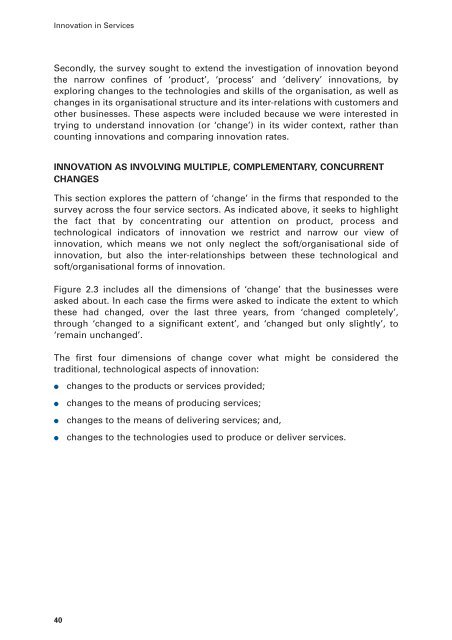Innovation in Services - Department for Business, Innovation and Skills
Innovation in Services - Department for Business, Innovation and Skills
Innovation in Services - Department for Business, Innovation and Skills
Create successful ePaper yourself
Turn your PDF publications into a flip-book with our unique Google optimized e-Paper software.
<strong>Innovation</strong> <strong>in</strong> <strong>Services</strong><br />
Secondly, the survey sought to extend the <strong>in</strong>vestigation of <strong>in</strong>novation beyond<br />
the narrow conf<strong>in</strong>es of ‘product’, ‘process’ <strong>and</strong> ‘delivery’ <strong>in</strong>novations, by<br />
explor<strong>in</strong>g changes to the technologies <strong>and</strong> skills of the organisation, as well as<br />
changes <strong>in</strong> its organisational structure <strong>and</strong> its <strong>in</strong>ter-relations with customers <strong>and</strong><br />
other bus<strong>in</strong>esses. These aspects were <strong>in</strong>cluded because we were <strong>in</strong>terested <strong>in</strong><br />
try<strong>in</strong>g to underst<strong>and</strong> <strong>in</strong>novation (or ‘change’) <strong>in</strong> its wider context, rather than<br />
count<strong>in</strong>g <strong>in</strong>novations <strong>and</strong> compar<strong>in</strong>g <strong>in</strong>novation rates.<br />
INNOVATION AS INVOLVING MULTIPLE, COMPLEMENTARY, CONCURRENT<br />
CHANGES<br />
This section explores the pattern of ‘change’ <strong>in</strong> the firms that responded to the<br />
survey across the four service sectors. As <strong>in</strong>dicated above, it seeks to highlight<br />
the fact that by concentrat<strong>in</strong>g our attention on product, process <strong>and</strong><br />
technological <strong>in</strong>dicators of <strong>in</strong>novation we restrict <strong>and</strong> narrow our view of<br />
<strong>in</strong>novation, which means we not only neglect the soft/organisational side of<br />
<strong>in</strong>novation, but also the <strong>in</strong>ter-relationships between these technological <strong>and</strong><br />
soft/organisational <strong>for</strong>ms of <strong>in</strong>novation.<br />
Figure 2.3 <strong>in</strong>cludes all the dimensions of ‘change’ that the bus<strong>in</strong>esses were<br />
asked about. In each case the firms were asked to <strong>in</strong>dicate the extent to which<br />
these had changed, over the last three years, from ‘changed completely’,<br />
through ‘changed to a significant extent’, <strong>and</strong> ‘changed but only slightly’, to<br />
‘rema<strong>in</strong> unchanged’.<br />
The first four dimensions of change cover what might be considered the<br />
traditional, technological aspects of <strong>in</strong>novation:<br />
● changes to the products or services provided;<br />
● changes to the means of produc<strong>in</strong>g services;<br />
● changes to the means of deliver<strong>in</strong>g services; <strong>and</strong>,<br />
● changes to the technologies used to produce or deliver services.<br />
40
















